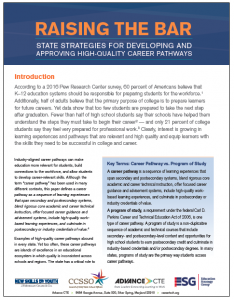While improving Career Technical Education (CTE) programs has always been a hallmark of the Carl D. Perkins Act, the Strengthening Career and Technical Education for the 21st Century Act (Perkins V) brings a new opportunity to put the quality of CTE programs front and center. Perkins V requires a description of how local recipients are approved for Perkins funding and how the local application promotes continuous improvement in the state plan, and the comprehensive local needs assessment that all local recipients must complete at the beginning of the grant (and update at least once every two years after that) includes a review of whether CTE programs are of sufficient size, scope, and quality to meet the needs of all students served by the local recipient and are meeting labor market needs. In addition, Perkins V provides the flexibility to states to use many other levers to require, incentivize and support program quality. How can states use the opportunity Perkins V offers to improve program quality? Check out the resources below to learn more.
 REPORT: Raising the Bar: State Strategies for Developing and Approving High-quality Career Pathways: All states have processes in place to review and approve career pathways, but not all use them to promote and uphold quality standards. This report describes a few approaches states can take — such as defining quality criteria, using fiscal and accountability policy to incentivize adoption, and providing regional supports — to promote quality through the pathways approval process.
REPORT: Raising the Bar: State Strategies for Developing and Approving High-quality Career Pathways: All states have processes in place to review and approve career pathways, but not all use them to promote and uphold quality standards. This report describes a few approaches states can take — such as defining quality criteria, using fiscal and accountability policy to incentivize adoption, and providing regional supports — to promote quality through the pathways approval process.
 TOOL: Policy Benchmark Tool: CTE Program of Study: This tool is designed to help states evaluate and strengthen their CTE program approval policies and processes. It lays out the non-negotiable elements of an effective policy for approving and evaluating programs of study, encompassing both secondary and postsecondary CTE, and offers an assessment rubric that state leaders can use to identify gaps in their current state policy and prioritize areas for improvement. The tool will also help states plan for implementation and program reapproval to ensure they have policies and programs that are high-quality and aligned with the state’s vision and definition of success.
TOOL: Policy Benchmark Tool: CTE Program of Study: This tool is designed to help states evaluate and strengthen their CTE program approval policies and processes. It lays out the non-negotiable elements of an effective policy for approving and evaluating programs of study, encompassing both secondary and postsecondary CTE, and offers an assessment rubric that state leaders can use to identify gaps in their current state policy and prioritize areas for improvement. The tool will also help states plan for implementation and program reapproval to ensure they have policies and programs that are high-quality and aligned with the state’s vision and definition of success.
 GUIDE: Ensuring Career Pathway Quality: A Guide to Pathway Intervention: As labor markets shift and contexts within districts and institutions change, all career pathways — including secondary and postsecondary pathways developed by the state, district or institution — must go through a natural life cycle. Once a career pathway has been approved and implemented, it is natural for the conditions that surround and support the pathway to change over time. This guide outlines the different types of intervention needed for pathways, and explores the steps leaders should take when making decisions to transform or phase out pathways that do not have labor market relevance.
GUIDE: Ensuring Career Pathway Quality: A Guide to Pathway Intervention: As labor markets shift and contexts within districts and institutions change, all career pathways — including secondary and postsecondary pathways developed by the state, district or institution — must go through a natural life cycle. Once a career pathway has been approved and implemented, it is natural for the conditions that surround and support the pathway to change over time. This guide outlines the different types of intervention needed for pathways, and explores the steps leaders should take when making decisions to transform or phase out pathways that do not have labor market relevance.
Policy Profiles
- Nebraska: ReVISION: Nebraska’s reVISION grant process allows schools to evaluate their career preparation and career guidance systems and receive state support to improve those systems in a way that is tailored to each school’s greatest areas of need.
- Florida: Postsecondary Program Approval and Articulation: The Florida College System and State Board of Education worked together to ease the burden of program approval processes by designing and validating curriculum frameworks at the state level.
- Tennessee: Standards Revision Process: The Tennessee Department of Education undertook three multi-step phases to overhaul the state’s CTE standards (which are organized into courses). This process brought the standards into alignment with the K-12 standards and embedded them within full and rigorous programs of study.
Looking for additional resources? Please be sure to check out the Learning that Works Resource Center.

